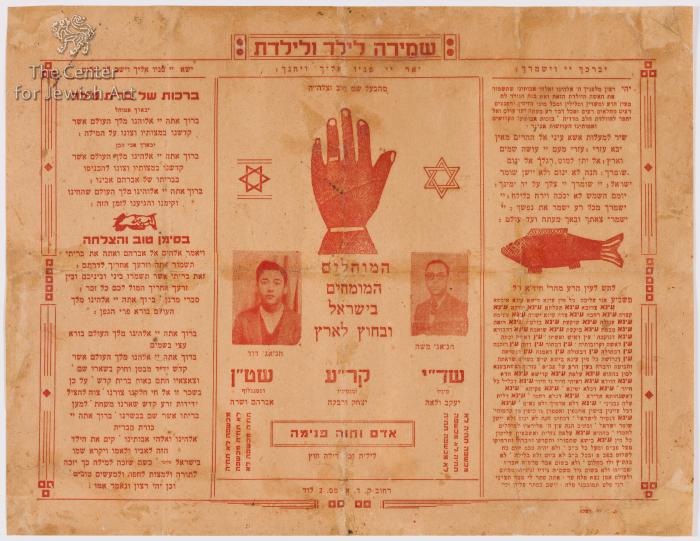Obj. ID: 54007 Shemirah le-Yeled ule-Yoledet, Ramleh, circa 1960

sub-set tree:
H | Human Figure | Hand | Hands, clasped
H | Hamsa
O | Ornamentation: | Full page framed
O | Ornamentation: | Title, framed
F | Fish
|
The following description was prepared by William Gross:
From earliest times, man has tried to protect himself from misfortune by the use of objects which he considered holy or otherwise (e.g., magically) potent. Amulets and talismans are Items generally worn around the neck or wrist, carried in a pocket or purse or hung on a wall. They are meant to protect or aid those who carried or wore them. The Hebrew word for amulet, kame‘a, has the root meaning "to bind". Jewish amulets are usually comprised of texts (either letters or graphic symbols) that are inscribed on some sort of material; some may also contain plant matter or precious stones. The texts of amulets usually include holy names that are believed to have the ability to affect reality, along with incantations summoning angels or other magical powers. For the most part, an amulet has a specific purpose: to ease childbirth, facilitate recovery from illness, improve one’s livelihood, and so on, but in the modern world many are also made for general protection.
Printed amulets that could serve the purpose of hand-written talismans began to appear in the late 17th century, continuing into the 18th and 19th centuries. The few surviving examples from this period are of European origin. The appearance of such printed amulets in North Africa did not occur until the 20th century simply because of the late establishment of printing houses in that area. But when the printing began in Morocco, Algeria, and Tunisia, a variety of such amulets were printed, particularly those for the protection of mother and child. The textual elements and form were by and large copied from Central and East European printed amulets. These include the invocation of Adam and Eve and the Patriarchs and their wives, the mention of Lilith, the names of the angels Sanoi, Sansanoi and Samangalaf, the text of Psalm 121 and the story of Eliyahu meeting Lilith.
A copy of the type of birth amulet printed in Tunis. This one is also an advertisement for a pair of brothers who are Mohalim who have immigrated to Israel and continue the traditions of the country they left. In Tunisia also such amulets were used as advertisements as in an example in the Gross family collection in which the advertisement is for a Patisserie.
Most Tunisian birth amulets for a male child were made in this large, horizontal format divided into three sections. The central third of the page basically copies the Habsburg-type printed birth amulet from Central Europe. The centrality of the image of the hamsa emphasizes its importance as the carrier of protection. The sections on the right and left are local additions with blessings for the Brit and other texts. This amulet is printed in red, a color that adds its own amuletic power to the page. The depiction of the fish adds the nuance for success and plenty. The text mentions that the amulet is based on the tradition of the Ba'al Shem Tov. The printing in green ink differentiates this sheet from most of those printed in Tunisia, which were rendered in red ink. They were all printed by the Uzan press, a firm that was the main Jewish printer in Tunis for many decades.


